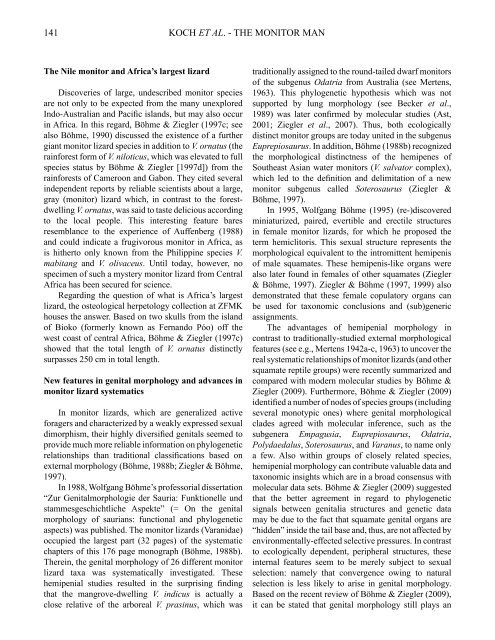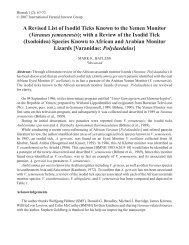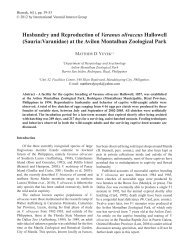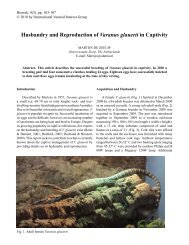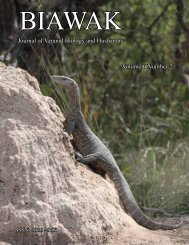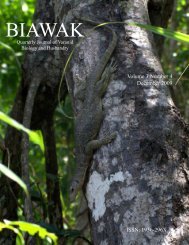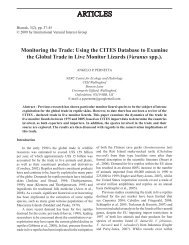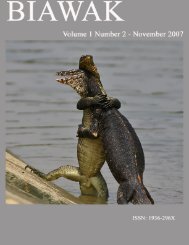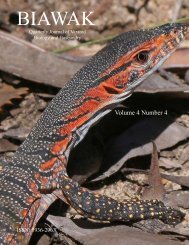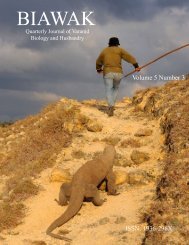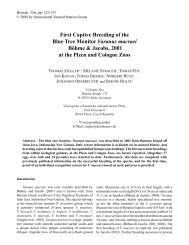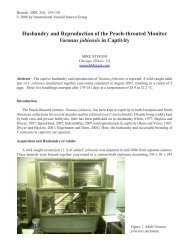BIAWAK - International Varanid Interest Group
BIAWAK - International Varanid Interest Group
BIAWAK - International Varanid Interest Group
- No tags were found...
You also want an ePaper? Increase the reach of your titles
YUMPU automatically turns print PDFs into web optimized ePapers that Google loves.
141<br />
KOCH ET AL. - THE MONITOR MAN<br />
The Nile monitor and Africa’s largest lizard<br />
Discoveries of large, undescribed monitor species<br />
are not only to be expected from the many unexplored<br />
Indo-Australian and Pacific islands, but may also occur<br />
in Africa. In this regard, Böhme & Ziegler (1997c; see<br />
also Böhme, 1990) discussed the existence of a further<br />
giant monitor lizard species in addition to V. ornatus (the<br />
rainforest form of V. niloticus, which was elevated to full<br />
species status by Böhme & Ziegler [1997d]) from the<br />
rainforests of Cameroon and Gabon. They cited several<br />
independent reports by reliable scientists about a large,<br />
gray (monitor) lizard which, in contrast to the forestdwelling<br />
V. ornatus, was said to taste delicious according<br />
to the local people. This interesting feature bares<br />
resemblance to the experience of Auffenberg (1988)<br />
and could indicate a frugivorous monitor in Africa, as<br />
is hitherto only known from the Philippine species V.<br />
mabitang and V. olivaceus. Until today, however, no<br />
specimen of such a mystery monitor lizard from Central<br />
Africa has been secured for science.<br />
Regarding the question of what is Africa’s largest<br />
lizard, the osteological herpetology collection at ZFMK<br />
houses the answer. Based on two skulls from the island<br />
of Bioko (formerly known as Fernando Póo) off the<br />
west coast of central Africa, Böhme & Ziegler (1997c)<br />
showed that the total length of V. ornatus distinctly<br />
surpasses 250 cm in total length.<br />
New features in genital morphology and advances in<br />
monitor lizard systematics<br />
In monitor lizards, which are generalized active<br />
foragers and characterized by a weakly expressed sexual<br />
dimorphism, their highly diversified genitals seemed to<br />
provide much more reliable information on phylogenetic<br />
relationships than traditional classifications based on<br />
external morphology (Böhme, 1988b; Ziegler & Böhme,<br />
1997).<br />
In 1988, Wolfgang Böhme’s professorial dissertation<br />
“Zur Genitalmorphologie der Sauria: Funktionelle und<br />
stammesgeschichtliche Aspekte” (= On the genital<br />
morphology of saurians: functional and phylogenetic<br />
aspects) was published. The monitor lizards (<strong>Varanid</strong>ae)<br />
occupied the largest part (32 pages) of the systematic<br />
chapters of this 176 page monograph (Böhme, 1988b).<br />
Therein, the genital morphology of 26 different monitor<br />
lizard taxa was systematically investigated. These<br />
hemipenial studies resulted in the surprising finding<br />
that the mangrove-dwelling V. indicus is actually a<br />
close relative of the arboreal V. prasinus, which was<br />
traditionally assigned to the round-tailed dwarf monitors<br />
of the subgenus Odatria from Australia (see Mertens,<br />
1963). This phylogenetic hypothesis which was not<br />
supported by lung morphology (see Becker et al.,<br />
1989) was later confirmed by molecular studies (Ast,<br />
2001; Ziegler et al., 2007). Thus, both ecologically<br />
distinct monitor groups are today united in the subgenus<br />
Euprepiosaurus. In addition, Böhme (1988b) recognized<br />
the morphological distinctness of the hemipenes of<br />
Southeast Asian water monitors (V. salvator complex),<br />
which led to the definition and delimitation of a new<br />
monitor subgenus called Soterosaurus (Ziegler &<br />
Böhme, 1997).<br />
In 1995, Wolfgang Böhme (1995) (re-)discovered<br />
miniaturized, paired, evertible and erectile structures<br />
in female monitor lizards, for which he proposed the<br />
term hemiclitoris. This sexual structure represents the<br />
morphological equivalent to the intromittent hemipenis<br />
of male squamates. These hemipenis-like organs were<br />
also later found in females of other squamates (Ziegler<br />
& Böhme, 1997). Ziegler & Böhme (1997, 1999) also<br />
demonstrated that these female copulatory organs can<br />
be used for taxonomic conclusions and (sub)generic<br />
assignments.<br />
The advantages of hemipenial morphology in<br />
contrast to traditionally-studied external morphological<br />
features (see e.g., Mertens 1942a-c, 1963) to uncover the<br />
real systematic relationships of monitor lizards (and other<br />
squamate reptile groups) were recently summarized and<br />
compared with modern molecular studies by Böhme &<br />
Ziegler (2009). Furthermore, Böhme & Ziegler (2009)<br />
identified a number of nodes of species groups (including<br />
several monotypic ones) where genital morphological<br />
clades agreed with molecular inference, such as the<br />
subgenera Empagusia, Euprepiosaurus, Odatria,<br />
Polydaedalus, Soterosaurus, and Varanus, to name only<br />
a few. Also within groups of closely related species,<br />
hemipenial morphology can contribute valuable data and<br />
taxonomic insights which are in a broad consensus with<br />
molecular data sets. Böhme & Ziegler (2009) suggested<br />
that the better agreement in regard to phylogenetic<br />
signals between genitalia structures and genetic data<br />
may be due to the fact that squamate genital organs are<br />
“hidden” inside the tail base and, thus, are not affected by<br />
environmentally-effected selective pressures. In contrast<br />
to ecologically dependent, peripheral structures, these<br />
internal features seem to be merely subject to sexual<br />
selection: namely that convergence owing to natural<br />
selection is less likely to arise in genital morphology.<br />
Based on the recent review of Böhme & Ziegler (2009),<br />
it can be stated that genital morphology still plays an


